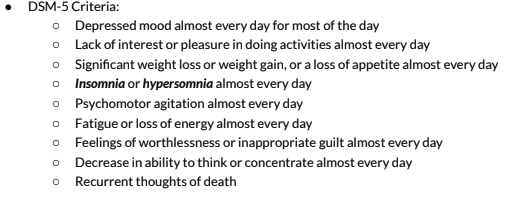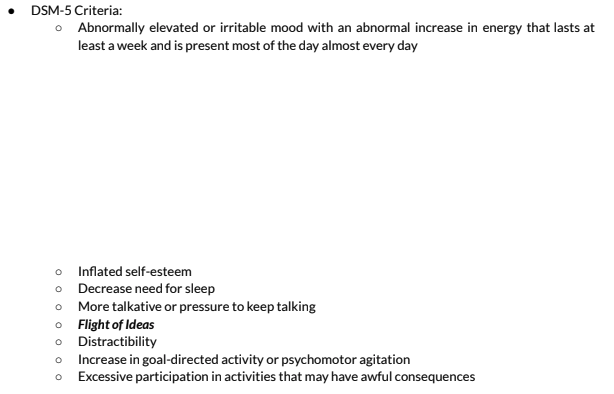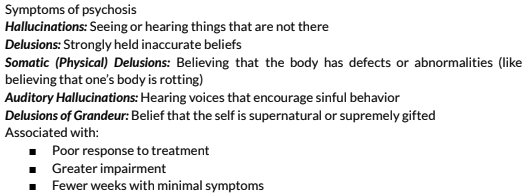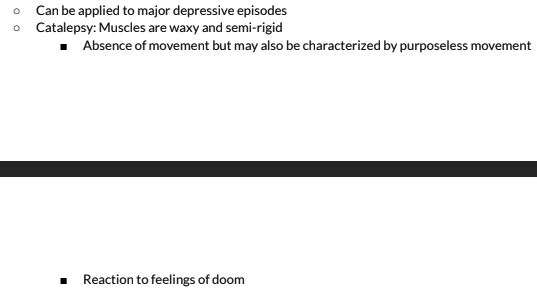Mood Disorders & Suicide
1/95
There's no tags or description
Looks like no tags are added yet.
Name | Mastery | Learn | Test | Matching | Spaced |
|---|
No study sessions yet.
96 Terms
Mood Disorders
It used to be called depressive disorders, affective disorders, and depressive neuroses, which refers to the gross deviations of mood
Major Depressive Episode
It is the most commonly diagnosed and most severe type of depression, lasting at least 2 weeks
Dysfunctional Reward Processing
It refers to the impairment in the brain that inhibits our ability to properly respond to rewarding stimuli
Anhedonia
It refers to the loss of energy and inability to have fun
Major Depressive Episode
Some of its central indications are somatic or vegetative symptoms, behavioral and emotional shutdown, and a duration of approximately 4 to 9 months if untreated
Major Depressive Episode

What disorder is this?
Mania
It is a disorder characterized by exaggerated pleasure or joy in every activity, hyperactive behavior that requires little sleep, develops grandiose plans, and has rapid speech that may become incoherent.
It lasts 3 to 4 months if left untreated.
Mania

What disorder is this?
Hypomania
It is a disorder characterized as less severe compared to manic, does not cause social or occupational functional impairment, and is not necessarily seen as problematic
Unipolar Mood Dsiorder
It refers to the mood that remains at one “pole” of the usual depression-mania continuum, which is usually seen in individuals who experience either depression or mania
Bipolar Mood Disorder
It refers to the mood that travels from one “pole” of the depression-mania continuum to the other end and back again, which may be misleading because depression and elation may not be at opposite ends of the same mood state
Mixed Features of Unipolar and Bipolar Mood Disorders
It refers to the experience of manic symptoms but also feeling somewhat depress or anxious simultaneously or vice versa
Predominant Polarity
It is said to exist when one polarity occurs during at least two-thirds of the person’s lifetime (usually the most often to occur in a person)
Full Remission
It refers to the full recovery of a patient within at least two months between episodes
Partial Remission
It refers to the patients who recovered but still retained some depressive symptoms
Chronic
It refers to an almost continuous course
Nonchronic
It refers to a shorter duration of course
Major Depressive Disorder

What is the diagnosis in this question?
Persistent Depressive Disorder

What is the diagnosis in this question?
Double Depression
It occurs when an individual experiences major depressive episodes and persistent depression with fewer symptoms
With Pure Dysthymic Syndrome
It refers to the diagnosis which didn’t meet the criteria for a major depressive episode in at least the preceding 2 years
With Persistent Major Depressive Episode
It indicates the presence of a major depressive episode over at least a duration of 2 years
With Intermittent Major Depressive Episodes, with Current Episode
It is the diagnosis where the criteria for major depressive disorder are fully met, but there have been periods of at least 8 weeks in at least the preceding 2 years with symptoms below the threshold for a full major depressive episode
With Intermittent Major Depressive Episodes, Without Current Episode
It is when the criteria for major depressive disorder are not currently fully met, but there has been one or more depressive episodes in at least the preceding 2 years
Psychotic Features Specifier
What basic Specifier to Describe Depressive Disorders is classified by this?

Anxious Distress Specifier
What basic Specifier to Describe Depressive Disorders is classified by this?

Mixed Features Specifier
It is one of the 8 basic specifiers to describe depressive disorders which refers to the predominantly depressive episodes that have several (at least 3) symptoms of mania
Melancholic Features Specifier
What basic Specifier to Describe Depressive Disorders is classified by this?

Catatonic Features Specifier
What basic Specifier to Describe Depressive Disorders is classified by this?

Atypical Features Specifier
What basic Specifier to Describe Depressive Disorders is classified by this?

Peripartum Onset Specifier
What basic Specifier to Describe Depressive Disorders is classified by this?

Seasonal Specifier
What basic Specifier to Describe Depressive Disorders is classified by this?

Prolonged Grief Disorder
It is classified by intense grief lasting 1+ year and can overlap with depression
Premenstrual Dysphoric Disorder
What type of depressive disorder is this?

Disruptive Mood Dysregulation Disorder
What type of depressive disorder is this?

Bipolar Disorders
It is also known as Manic-Depressive Illness which involves extreme mood swings between manic (or hypomanic) and major depressive episodes
Bipolar II Disorder
It refers to the alternating major depressive episodes with hypomanic episodes (less severe than full mania)
Bipolar I Disorder
It includes full manic episodes alongside major depressive episodes
Manic Episodes
It refers to when individuals may not recognize their behavior as problematic, engaging in reckless actions like excessive spending due to euphoria
Cyclothymic Disorder
It is a milder, chronic form with alternating mild mood elevations and depression, lasting at least 2 years and increases the risk of developing severe bipolar disorders, so treatment is essential to prevent progression
Catatonic Features Specifier
It refers to bipolar disorder specifiers which is said to be rare in manic episodes but common in depressive episodes
Psychotic Features Specifier
It refers to bipolar disorder specifiers that is common in manic episodes with delusions of grandeur
Anxious Distress Specifier
It refers to bipolar disorder specifiers that is present in both bipolar and depressive disorders
Mixed Features Specifier
It refers to bipolar disorder specifiers that are newly introduced in the DSM-5, which describes episodes with symptoms from both extremes (e.g., depression with manic symptoms)
Seasonal Pattern Specifier
It refers to bipolar disorder specifiers that occur in timelines of depression in winter, mania in summer
Peripartum Onset Specifier
It refers to bipolar disorder specifiers that refer to manic episodes around childbirth
Rapid-Cycling Specifier
What Bipolar Disorder Specifier is described here?

Proband
It is referred to as the first person in a family who is diagnosed with a mental illness of disorder
Serotonin
Low levels of _____ causes mood disorders, but only in relation to other neurotransmitter, including norepinephrine and dopamine
Antidepressants
It is a medication that increases neurotransmitter activity t
Selective-Serotonin Reuptake Inhibitors
It is a type of antidepressant which specifically block the presynaptic reuptake of serotonin, which temporarily increases levels of serotonin at the receptor site, having the best-known example is fluoxetine (Prozac)
Mixed Reuptake Inhibitors
It is a type of antidepressant which belongs to a different class that have a different neurobiological action, blocking the reuptake of norepinephrine and serotonin while having similar side effects with other SSRIs
Monoamine Oxidase Inhibitors
It blocks the enzyme MAO, which breaks down neurotransmitters like norepinephrine and serotonin, having the effects that are closely related with tricyclic antidepressants, but is only used if other antidepressants are not effective as it possess unwanted consequences
Monoamine Oxidase Inhibitors
One of the consequences of taking _______ can lead to severe hypertensive episodes and occasionally, death
Tricyclic Antidepressants
It is the most widely used treatments for depression before the introduction of SSRIs, but now is used less commonly because of its dangerous side effects such as being lethal when done in excessive doses
Treatment-Resistant Depression
It refers to individuals who experiences no responses when taking drug treatments, rendering the medication ineffective
Sequenced Treatment Alternative to Relieve Depression
It is a large study that examines the usefulness of an alternative drug to individuals who are experiencing treatment-resistant symptoms from their initial prescribed treatment
Lithium Carbonate
It is another type of antidepressant drug, a common salt often referred to as mood-stabilizing drug. It is often effective in preventing and treating manic episodes, but the dosage must be carefully regulated. It remains to be the gold standard for treating bipolar disorders.
Valproate
It is known as the most commonly prescribed mood stabilizer for bipolar disorder, equally effective for reducing manic symptoms as lithium, even for patients with rapid-cycling symptoms
Valproate
One distinct disadvantage of ______ is its decreased effectiveness in preventing suicide compared to lithium
Electroconvulsive Therapy
It is the most controversial treatment for psychological disorders after psychosurgery but is recently deemed safe and reasonably effective for treating severe depression that do not improve with other treatments like medication
Transcranial Magnetic Stimulation
It alters the electrical activity in the brain by introducing a strong magnetic field, generating a precisely localized electromagnetic pules. Anesthesia is not required and side effects are limited, but it is not as effective as ECT and is more comparable with antidepressant medications
Vagus Nerve Stimulation
It implants a pacemaker-like device that generates pulses to the vagus nerve in the neck, which is thought to influence neurotransmitter production in the brain stem and limbic system. However, results are generally week therefore reducing its utility.
Deep Brain Stimulation
Its process includes a surgically implanted electrode in the limbic system that are connected to a pacemaker-like device. Results show promise in treatment-resistant patients but no conclusive evidence has been found
Cognitive Behavioral Therapy
it is made by Aaron Beck where the treatment involves correcting cognitive errors and substituting less depressing, more realistic thoughts and appraisals
Cognitive-Behavioral Analysis System of Psychotherapy
It is made by McCullough, which integrates cognitive, behavioral, and interpersonal strategies and focuses on problem-solving skills, particularly in the context of relationships. It is usually designed for individuals with persistent (chronic) depression
Mindfulness-Based Cognitive Therapy
It is effective for treating depression and preventing future depressive relapse and recurrence. This approach seems particularly effective for individuals with more severe disorders, indicated by a history of three or more prior depressive episodes.
Behavioral Treatment (Increased Activity)
It is proposed by Neil Jacobson and colleagues where increased activities alone can improve self-concept and lift depression, focusing on preventing avoidance of social and environmental cues that produce negative affect or depression and result in avoidance and inactivity
Interpersonal Psychotherapy
It is initially proposed by Klerman and Weissman, focusing on resolving problems in existing relationships and learning to form important new interpersonal relationships
Negotiation Stage
It is the stage of awareness of the dispute while attempting to renegotiate it
Impasse Stage
It is the stage where the dispute smolders beneath the surface and reveals low-level resentment, but no attempts are made to resolve it
Resolution Stage
It is the stage where the action is taken in hopes to conclude or resolve the dispute
Prevention Programs
It takes the possibility to “psychologically immunize” at-risk children and adolescents against depression by teaching appropriate cognitive and social skills before they enter puberty
Universal Programs
It refers to prevention programs that are applicable to everyone
Selected Interventions
It refers to prevention programs that target individuals at risk for depression
Indicated Intervention
These are prevention programs that targets individuals already showing mild symptoms of depression
Interpersonal and Social Rhythm Therapy
It is made by Ellen Frank and her colleagues, which regulates circadian rhythms by helping patients regulate eating and sleep cycles and other daily schedules as well as cope more effectively with stressful life events, particularly interpersonal issues
Suicide
According to Hazel & Runeson, it is the leading cause of death globally among individuals aged 15-24
Suicidal Ideation
It refers to the contemplation of suicide
Suicidal Plans
It is the stage of formulation of specific methods to kill oneself
Suicidal Attempts
It refers to the person’s survival from a suicide execution
Anomic Suicides
This refers to the suicide that are often caused by significant disruptions, such as the sudden loss of a high-prestige job, leading to feelings of loss and confusion
Fatalistic Suicides
This type of suicide results from a person’s loss of control over their own destiny
Psychological Autopsy
It refers to the psychological profile of a suicide victim that is gathered through extensive interviews with friends and family members who may have known about their thoughts and action before their death
Hopelessness
It is a specific component of depression that is a strong predictor of suicide, which also predicts suicide among individuals whose primary mental health problem is not depression
Interpersonal Theory of Suicide
It is a perception of oneself as a burden on others and a diminished sense of belonging as powerful predictors of hopelessness and subsequently suicide
Werther Effect
It is the story where the person ends up dying by shooting himself to escape the emotional pain caused by his unrequited love, where men sometimes dressed in the same clothing as the person and kill themselves with the same kind of pistol described from the story
Papageno Effect
It is an opera of Mozart where the person contemplates suicide but chooses a different option after other characters suggest more adaptive ways to resolve his problems
Suicidal Desire
It is the ideation, hopelessness, burdensomeness, and feeling of trappedness that clinicians must assess in a suicidal person
Suicidal Capability
It refers to the the past attempts, high anxiety and/or rage, and available means that clinicians must assess in a suicidal person
Suicidal Intent
It refers to the available plan, expressed intent to die, and preparatory behavior that clinicians must assess in a suicidal person
Substance/Medication-Induced Depressive Disorder
This is characterized by persistent mood disturbances, markedly diminished interest or pleasure in activities, and is predominant in clinical presentations
Anhedonia
It refers to a persistent mood disturbance, characterized by depressed mood or reduced interest or pleasure in all or almost all activities, and is predominant in clinical presentations
Etiology
It refers to evidences from history, physical examination, or laboratory findings, which indicates symptoms developed during or after substance intoxication, withdrawal, or medication exposure, and the substance/medication is capable of producing these symtpoms
Comorbidity
It states that disturbances does not occur exclusively during the course of a delirium
Prevalence
It refers to when disturbances cause clinically significant distress or impairment in social, occupational, or other important areas of functioning